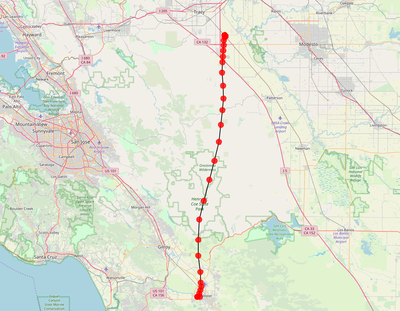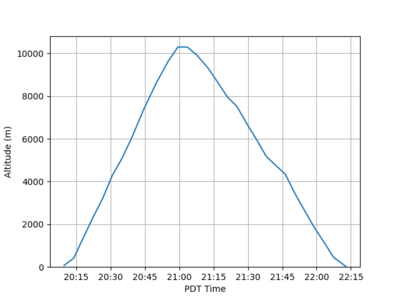Difference between revisions of "SSI-92"
m |
|||
| Line 1: | Line 1: | ||
{{balloon-launch | {{balloon-launch | ||
| − | | header = SSI- | + | | header = SSI-92 |
| img link = | | img link = | ||
| designations = '''CY-6''' | | designations = '''CY-6''' | ||
| Line 69: | Line 69: | ||
'''October 9 1035 PDT''' Last RockBlock comm, having shown no movement since landing. | '''October 9 1035 PDT''' Last RockBlock comm, having shown no movement since landing. | ||
| − | |||
| − | |||
| − | |||
| − | |||
| − | |||
| − | |||
Revision as of 08:39, 6 December 2019
| SSI-92 | ||||
|---|---|---|---|---|
| Designations | CY-6 | |||
| Launch date | October 5, 2019, 11:00 PDT | |||
| Launch site | Brigantino Park, Hollister, CA | |||
| Launch coordinates | 36.849, -121.433 | |||
| Flight duration | 9h:28m | |||
| Flight profile | Standard zero pressure | |||
| Landing time | October 5, 2019, 20:38 PDT | |||
| Landing site | 16 km SSW of Alamo, Lincoln County, NV | |||
| Landing coordinates | 37.144, -115.262 | |||
| ||||
SSI-92 (project designation CY-6) was the sixth launch of Project Cycloon on October 5, 2019. It was the first interstate Cycloon flight (and to-date longest distance), the first launch of a poly tubing ZPB, and the first ZPB flight for which telemetry at equilibrium and descent was acquired since SSI-20. This enabled the acquisition of valuable thermal data and verification of equilibrium altitude predictions. Continuing a trend, the payload was lighter still than that of its predecessor, SSI-91.
Project context
SSI-91 was a milestone in realizing flights with in-house manufactured ZPBs, yet due to unexpected termination no data on the equilibrium altitude and descent characteristics were obtained, thus failing to fulfill one of the major objectives of that flight. Meanwhile, a candid assessment of the ZPB manufacturing process proved discouraging. In mid to late August, a new manufacturing technique was devised based on commercially available polyethylene tubing, which promised to be far more durable and scalable. (The altitude limitations were deemed acceptable for the time being). Orders for commercial tubing were placed, set to arrive in September. In light of these developments, a third summer ZPB launch which had been planned for the weekend of September 1 was cancelled.
With the end of the summer, onboarding approached, and it was hoped to do a Cycloon demonstration launch very near the beginning of the year, on October 5, 2019. Ideally this would be ballast-controlled, collecting data and paving the way for a fully controlled launch in the middle of the quarter. It was also hoped to do this launch from Pigeon Point, but by September 23, wind forecasts proved unfavorable. Additionally, momentarily it was planned to launch two ballast controlled balloons (as a means of forcing Cycloon to self-manufacture a ballast mechanism), but as 3D printing attempts in the last week of September failed, it was decided to fly only one standard (non-controlled) ZPB. Nevertheless, a significant worksession on September 29 produced two balloons and two sets of avionics (one new, one recovered from SSI-91.
Relatively close to the day of the launch, demands for an improved cutdown mechanism intensified. Amidst an absence of nichrome, a novel cutdown mechanism involving two ematches and a socket was devised, implemented, and tested the night of October 4.
Configuration
Balloon: 0.8 mil polyethylene tubing, paper bag topology, width 2.5 m, length 10 m, volume approximately 17.5 cubic meters. Total mass 1 kg with fill tube (PVC of length approximately 12 inches and diameter 1/2 inch).
Avionics: TinyGPS, Teensy 3.2, BMP 280 transmitting at adjustable intervals over Rockblock. A SPOT Trace was accidentally omitted. This set of avionics was recovered from CY-5. Controlled novel cutdown mechanism.
Power: 9 L91 lithium AA batteries. 3 L91 lithium AA batteries on cutdown.
Payload: Styrofoam enclosure. Mass 0.55 kg
Mass budget: 1.57 kg total.
Flight synopsis
Conditions at the launch site were ideal. Inflation was remarkably uneventful.
October 5 1100 PDT: Balloon released --- no running start needed. Free lift was measured at approximately 0.5 kg. Initial ascent at about 2.5 m/s. Nearly no horizontal initial motion, followed by a gradual drift to the southwest and then southeast.
October 5 1219 PDT: Balloon appeared to equilibrate at 17.43 km, having ascended at 4 - 5 m/s in the second half of its ascent. Within significant figures, this was essential equal to the predicted equilibration altitude of 17.37 km. At the point the balloon had been moving due east and had been crossing the Diablo range.
October 5 1225 PDT Balloon reached a maximum altitude of 17463 m, at 36.929, -120.947 over the eastern foothills of the Diablo range. In the ensuing hours, the trajectory fluctuated within the rates of +/- 0.3 m/s, which was considered a very successful equilibration.
October 5 1547 PDT At this time, the balloon was over the peaks of the Sierra Nevada (John Muir wilderness), yet still held an altitude of 16.4 km.
October 5 1602 PDT GPS lost lock over 37.198, -118.72 at an altitude of 16330 km. This sparked intense speculation, and the rapidly dropping temperature of -22 C was momentarily blamed. During the lock, the barometer and Iridium triangulation functioned as telemetry.
October 5 1729 PDT In the previous 15 minutes, Iridium had been reporting with increasing confidence from Nevada, so an interstate transition was declared. By this time, the balloon was just above 15 km in altitude, having stalled its descent over the past half hour. Now, however, descent began in earnest.
October 5 1839 PDT Altitude was around 13.8 km, and descent rate increased to around 1 m/s, marking an inflection point. Landing was predicted near St George, UT.
October 5 1903 PDT Altitude near 11.5 km. Descent rate stabilized near 2 m/s and fluctuated around this value for the next hour or so.
October 5 1917 PDT GPS signal returned at an altitude of 9745 m. The temperature was -37 C, disfavoring the cold hypothesis. Instead, the threshholds of 10 km and 1600 PDT were noted with suspicion.
October 5 1924 PDT At an altitude of 8914 m and a descent rate just above 2 m/s, an impact at 2030 PDT near US-93 was predicted.
October 5 1828 PDT Landing declared at a ground elevation of 1511 m. Descent just before impact had slowed somewhat, consistent with predictions.
October 9 1035 PDT Last RockBlock comm, having shown no movement since landing.
| Balloon Launches | |
|---|---|
| 2014-15 | SSI-19 • 20 • 21 • 22 |
| 2015-16 | SSI-23(a) • 24 • 25 • 26 • 27 • 28 • 29 • 30 • 31 • 32 • 33 • 34 • 35 • 36 • 37 • 38 • 39 • 40 • 41 • 42 • 43 |
| 2016-17 | 44 • 45 • 46 • 47 • 48 • 49 • 50 • 51 • 52 |
| 2017-18 | |
| 2018-19 | 83 • 86 • 87 • 90 • 91 |
| 2019-20 | 92 • 93 • 97 |
| V • E | |


